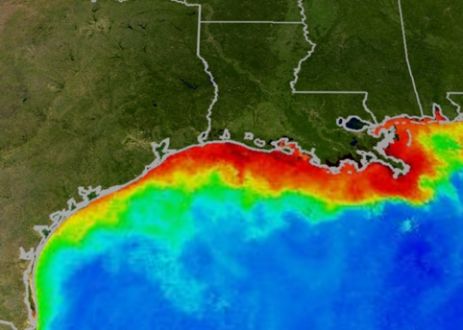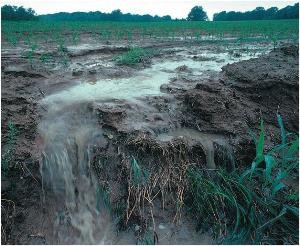
Satellite view of the Gulf. In the red areas, a vast, nitrogen-fed algae bloom has risen, blotting out most sea life underneath. NASA-NOAH image
To understand our impact on nature, there is truth in the saying, “everything is connected.” Few situations illustrate this concept as dramatically as the agricultural wastes from the Midwest that contribute so seriously to the aquatic dead zone in the Gulf of Mexico.
Human activities and natural phenomena occurring on land masses combine to impact air quality and small-scale climate systems. Wastes and sediments flowing off lands affect natural concentrations of nutrients in water and the health of aquatic habitats. Gases suspended in air dissolve into sea water and disrupt the normal chemistry of oceans.
These releases, often invisible where the problems originate, can have repercussions in other states or nations through natural systems that are not at all limited by political boundaries. Time and distance too often obscure the impacts, hiding unintended or unknown connections with downstream costs.
Take the example of crops growing hundreds of miles inland in the “I-states,” and the putrefying aquatic ecosystems in the Gulf of Mexico. The Mississippi River Basin empties into the Gulf below New Orleans. It drains the U.S. Heartland and upper Midwest, home to most of the country’s prime agricultural land outside the state of California. Lots of fertilizer is applied every year in this watershed to produce lots of non-organic corn, soybeans, cotton, and rice. Massive amounts of agricultural nutrients escape these fields through erosion, runoff, and leaching through soil into groundwater. These intended-nutrients-turned-agricultural-pollutants have disastrous effects when they accumulate in the Gulf waters.
“Dead Zone” The term sounds morbidly ominous, with good reason. During the summer months, a huge amount of water with limited dissolved oxygen ranging from 5,000 to 8,000 square miles in size (approximately the size of Connecticut to that of New Jersey) forms in the Gulf.
Nitrogen and phosphorus runoff nourishes algae, causing massive blooms in the water. As algae decompose, oxygen is removed from the water. Aquatic life forms are asphyxiated and die off. Stocks of large fish dependent on these tiny plants for food are affected, causing fishermen to experience a lower catch and the possible loss of their livelihoods. Result: U.S. consumers are deprived of seafood from one of the nation’s most important fisheries.
Down on the farm
The Gulf of Mexico dead zone has been a huge problem for the past 20 years impacting all states with significant fisheries along the gulf’s borders: Texas, Louisiana, Mississippi, Alabama, and Florida. The production losses of shrimp, crabs, grouper, and red snapper from the unique region impact domestic seafood commerce across the country.
Why hasn’t its agricultural cause been aggressively addressed, instead of being treated almost as a cost of doing business?
Federal farm policy designates billions of dollars to fund agriculture through production subsidies. Because subsidy income is based on yield rather than ecological impact, applying fertilizer is considered essential to optimizing commodity production. Trouble is, too much of that fertility leaves the fields. Research conducted by the Environmental Working Group indicates that when spring runoff pollution is at its highest, more than 7.8 million pounds of fertilizer nitrate flow down the Mississippi River to the Gulf of Mexico every day. The United States Geological Society has identified Illinois, Iowa, Indiana, Missouri, Arkansas, Kentucky, Tennessee, Ohio, and Mississippi as the primary contributors within the far-reaching watershed. These states only make up a third of the Mississippi River Basin’s area, and yet are responsible for more than 75 percent of the nitrogen and phosphorus that enters the gulf.
The Clean Water Act was created to improve the nation’s waters so that natural chemical, physical, and biological conditions could be sustained. The legislation determined that pollution from point and nonpoint sources should be minimized, however it can be difficult to identify and reduce nonpoint source pollution such as fertilizer runoff from agricultural operations. Relatively little effort has been undertaken to control nonpoint source pollution, with waterways and fisheries around the country suffering as a result.
 Fertilizer runoff ends up in streams–and eventually down the Mississippi and into the Gulf. Photo: Rodale InstThe availability of money for the production of subsidized crops compared to the funding provided for conservation programs pinpoints a main reason the gulf’s dead zone exists. Commodity payments between 1995 and 2002 totaled $59.7 billion while conservation subsidies were $8.5 billion. These imbalanced incentives will result in the further depletion of water quality, enlarging the extent of the gulf’s dead zone and affecting additional fisheries.
Fertilizer runoff ends up in streams–and eventually down the Mississippi and into the Gulf. Photo: Rodale InstThe availability of money for the production of subsidized crops compared to the funding provided for conservation programs pinpoints a main reason the gulf’s dead zone exists. Commodity payments between 1995 and 2002 totaled $59.7 billion while conservation subsidies were $8.5 billion. These imbalanced incentives will result in the further depletion of water quality, enlarging the extent of the gulf’s dead zone and affecting additional fisheries.
Reviving the dead zone
The situation in the Gulf of Mexico is dismal, but certainly not hopeless. A shifting of some funding towards conservation and away from commodity subsidies could have a significant impact on reducing the size of the dead zone. A modest change in current farm policy that directs funding away from degraded lands and towards the conservation of working lands would allow more members of the farming community to benefit from payments.
The federal government is working pro-actively to reduce the dead zone after years of taking a hands-off approach to states’ struggles with limiting pollution from nonpoint sources. A federal-state task force is addressing the problem and the EPA has presented targets to reduce nitrogen and phosphorus by 45 percent by 2015 to limit the size of the dead zone.
Whatever strategies are ultimately undertaken, two main steps to reduce agricultural pollution reaching the gulf are needed: cut application rates so crops absorb more of the fertilizer, and improve barriers to intercept whatever fertility escapes plant uptake. Nutrient management plans coupled with nitrate tests effectively identify how much fertilizer is actually needed for agricultural productivity, reducing wasteful application.
Another solution would involve converting acres of cropland to organically-grown agriculture that greatly increases soil organic matter and includes nutrient-retaining “trap” crops. Returning crop land to pasture and growing more multi-year forage crops would reduce soil erosion risks and the need for applied fertility. These steps would also increase nutrient retention and water management in wet seasons or floods. Further benefits from organic systems would include more microbiologic activity in soils and greater regional biodiversity.
The Gulf of Mexico dead zone is an intricate problem with a complicated root cause. Dead zones illustrate the connectivity between natural systems and human actions, as water quality and aquatic health react to nutrient pollution. Attacking the problem will be helped by education on the links between farms and the Gulf, and will be further spurred by decreasing subsidy incentives tied to crop yield or some real disincentive for agriculture-related pollution.
Thanks to individuals seeking sustainable innovations that will reduce the escape of nutrients from feedlots and fields, it may be possible to revive a critical fishery through better-managed agricultural production.
This article originally appeared on the Rodale Institute’s website.



